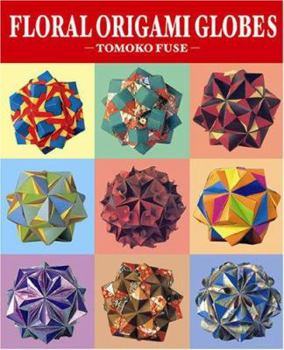Floral Origami Globes
With step-by-step diagrams, detailed instructions and vibrant color photos, internationally-renowned origamist and author Tomoko Fuse offers an innovative approach to origami based on assembling... This description may be from another edition of this product.
Format:Paperback
Language:English
ISBN:4889962131
ISBN13:9784889962130
Release Date:May 2007
Publisher:Japan Publications Trading
Length:98 Pages
Weight:1.05 lbs.
Dimensions:0.4" x 8.4" x 10.1"
Related Subjects
Crafts Crafts & Hobbies Crafts & Hobbies Origami Papercrafts, Stamping & StencilingCustomer Reviews
5 ratings
too much work... but it's worth it
Published by Thriftbooks.com User , 15 years ago
At first, I thought most modules were to be folded from one or more pieces of square paper, but it turns out you need to cut the papers in half (1:2 sized papers), for every base and face parts of each module. Even so, all this work worth it since the results are very rich colored and beautiful structures, perfect for gifts. I've been using 7.5cm size papers, and this results in a 30-unit structure that can be held in your palm. They are great for decorations in your baby room! Obviously, in order to obtain beautiful models as in illustrated on the book, you need to purchase different types and textures of origami papers, which are rare to find... at least, in an affordable price here in Brazil. And you need tons of paper!
Clear Instructions but a serious translation error
Published by Thriftbooks.com User , 16 years ago
My wife is a fan of Tomoko Fuse's work and purchased this book for its clear instructions and excellent illustrations. Unfortunately, she began her first projects using the English dimensions for the paper sheet size specified in the book and quickly found that those dimensions will not work. The projects call for sheets which are 12cm X 6cm or a perfect 2 to 1 ratio. Every time these metric dimensions are mentioned in the book, English system dimensions of 4-1/4 in X 2-1/2 in are also listed. A sheet that is actually 12cm X 6cm would convert to 4.724in X 2.362in, maintaining the 2:1 ratio. The dimensions listed simply won't work as my wife soon discovered. Using sheets that are 4-3/4 X 2-3/8 or 5 X 2-1/2 will work fine, but having the wrong sizes listed is sure to confuse beginners. Hopefully this gross dimension conversion error will be corrected in future editions. Obviously, several of the previous reviewers are from countries, who, unlike the United States, and like most of the civilized world use a superior system of measurements instead of holding on to a outmoded system which should have been replaced years ago. However, since this is an English edition, the conversion error should be addressed.
Take the best off your papers
Published by Thriftbooks.com User , 16 years ago
It's a wonderfull book, that teach we do a various sonobes variations and in many times we use two or tree papers to make a unit and you can use simple colored papers to get a great effect. And this book teach to do same cubes and variations of sonobe cubes.
Decorated modular polyhedra
Published by Thriftbooks.com User , 16 years ago
I feel a little guilty about docking a star from this book just because it wasn't quite what I expected, but I've still gotta go with my gut feeling. The title suggested similar content to Tomoko Fuse's excellent previous book, "Kusudama Origami"; in that case, there were a few traditional kusudama made by sewing together the points of conical modules to form a globe, but most of the models began with variously decorated square faces which could be attached together (some with glue, some without) to form hollow cubelike polyhedra. Most of those polyhedra required only six face units plus six quarter-square decorations and some simple edge or corner hinges to hold them together, so maybe 8-11 squares of paper altogether. Instead, this book is closer in spirit to Fuse's "Unit Origami: Multidimensional Transformations". All of the models are based on the same concept, where a fairly large number of rhomboid units (each one actually made of two half-squares) are joined together to form the final shape-- the stellated dodecahedra in most of the illustrations require 30 units each; the slightly simpler stellated octahedra require 12 units each. (There are also instructions to assemble six units into simple cubes, but imho they don't look interesting enough to be worth the effort.) Once the basic module assembly is established, the rest of the book lays out different cosmetic variations of the same sort of rhomboid units. Some of the units' decorations are made from silver rectangles instead of half-squares. That's all. It's a beautiful book with even higher production values than "Kusudama Origami", where there were a few full-color photographs in the front but the later diagrams and photos were chromatically squashed down into black/white/red-- "Floral Origami Globes" has full-color photos throughout the entire book, accompanying the clearly drawn diagrams of every module variation. If you have no objection to the idea of using 30 squares of paper to make 30 identical units for each model as shown in the photographs, then this should be a perfect five-star title for you. Sadly, the prospect already has me dreading deep tedium and the need for lots and lots of paper.
Floral Origami Globes
Published by Thriftbooks.com User , 16 years ago
Sencillamente maravilloso. En línea con todos los libros de Tomoko Fuse. Diagramas de gran calidad, y modelos espectaculares.





